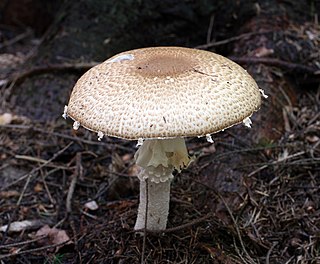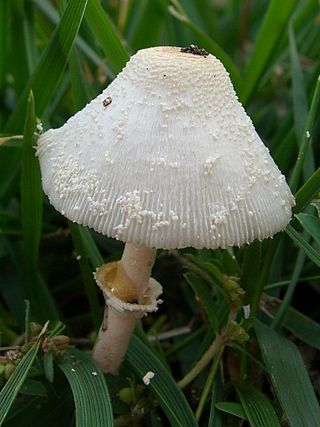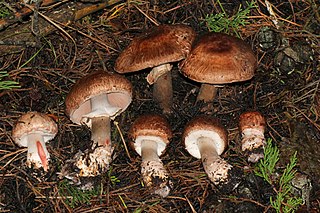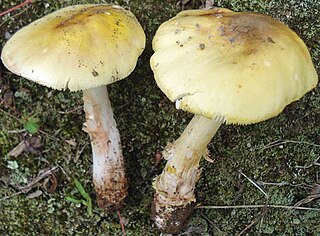
Agaricus xanthodermus, commonly known as the yellow-staining agaricus, yellow-staining mushroom or yellow-stainer, is a mushroom of the genus Agaricus, which displays a strong yellow colouration at the base of the stem when cut. It has a phenolic smell. It is poisonous for most people, causing gastrointestinal upset, but can be eaten by some without apparent negative effect.

Leratiomyces ceres, commonly known as the chip cherry or redlead roundhead, is mushroom which has a bright red to orange cap and dark purple-brown spore deposit. It is usually found growing gregariously on wood chips and is one of the most common and most distinctive mushrooms found in that habitat. It is common on wood chips and lawns in North America, Europe, Australia, New Zealand and elsewhere. The name Stropharia aurantiaca has been used extensively but incorrectly for this mushroom.

Agaricus augustus, known commonly as the prince, is a basidiomycete fungus of the genus Agaricus.

Agaricus bernardii, commonly called the salt-loving agaricus, or salty mushroom, is an agaric fungus in the family Agaricaceae. The mushroom's thick stem is usually shorter than the diameter of the cap, which ranges from 5–15 centimetres and is convex to flattened. The cap surface is whitish to buff, and can develop scales or warts in age. The gills are initially pink before turning brown when the spores mature. The flesh turns reddish when it is cut or bruised. It resembles species such as A. bitorquis.

Leucocoprinus cepistipes, is a species of fungus in the family Agaricaceae. It is typically found on wood debris, such as wood chips but may also grow in potted plants or greenhouses. Typical characteristics include a fine-scaled bell-shaped cap, a partial veil, and a tendency to bruise a yellow to brown when handled.

Agaricus semotus is a woodland mushroom of the fungus order Agaricales. Like many of its relatives, it can be found spread throughout wooded, moist areas in the southern United States, and has been found in areas ranging from California to Florida. It is also indigenous to Great Britain and Europe. A. semotus has also been collected in New Zealand. Although various authors disagree about its edibility, its modest size prevents it from being a significant source of nutrition.

Agaricus placomyces is a toxic basidiomycete fungus of the genus Agaricus. It is found in North America; the Eurasian populations formerly known by the same scientific name are nowadays known as A. moelleri, while the present species may also be referred to as A. praeclaresquamosus.

Agaricus albolutescens, commonly known as the amber-staining agaricus, is a moderate-sized, stocky-statured mushroom with a pleasant odor; it bruises slowly but persistently yellow.

Agaricus perobscurus, commonly known collectively with its close European relative Agaricus lanipes as the princess, is a basidiomycete fungus. A relative of Agaricus augustus, known as the prince, A. perobscurus can be differentiated in several aspects. While the prince is widely distributed in North America, the princess is found only in the San Francisco Bay Area. Besides its smaller size, it is distinguished from Agaricus augustus by a darker-brown cap, a patchy fibrillose stipe surface at youth, lacking densely floccose-scaly, and a different fruiting season. Another commonly closely associated Agaricus species, Agaricus praeclaresquamosus, is toxic. It can be differentiated by its dark-grey cap, a phenolic, rather than an anise odor, and a stipe base which yellows immediately when injured.

Agaricus dulcidulus is a small mushroom in the family Agaricaceae of the order Agaricales, found in deciduous woodlands of Europe, but also recorded in North America, North Africa and Asia. The English name is rosy wood mushroom. Despite the tendency of some sources to synonymize it with Agaricus semotus, this is a distinct taxon.

Agaricus benesii is an agaric mushroom of the genus Agaricus known in English as the mull mushroom. This mushroom can be distinguished by a white cap that bruises pinkish-red when injured, a scaly lower stipe, and a conifer habitat. Similar to Agaricus californicus and A. xanthodermus, the cap discolors brown in age. A distinguishing feature of A. californicus and A. xanthodermus, however, is a thickened annulus at the margin, a phenolic odor, and a yellowing bruise, instead of red. In the case of Agaricus xanthodermus, it occurs quickly, though faintly to not at all in the case of A. californicus. Another similar species, Agaricus bernardii, also stains red and has white flesh, but differentiates on its larger bulk, a sheathing veil, briny odor, and different habitat, namely grass.

Mycena inclinata, commonly known as the clustered bonnet or the oak-stump bonnet cap, is a species of mushroom in the family Mycenaceae. The doubtfully edible mushroom has a reddish-brown bell-shaped cap up to 4.5 cm (1.8 in) in diameter. The thin stem is up to 9 cm (3.5 in) tall, whitish to yellow-brown at the top but progressively becoming reddish-brown towards the base in maturity, where they are covered by a yellowish mycelium that can be up to a third of the length of the stem. The gills are pale brown to pinkish, and the spore print is white. It is a widespread saprobic fungus, and has been found in Europe, North Africa, Asia, Australasia, and North America, where it grows in small groups or tufts on fallen logs and stumps, especially of oak. British mycologist E.J.H. Corner has described two varieties of the mushroom from Borneo. Lookalike species with which M. inclinata may be confused include M. galericulata and M. maculata.

Agaricus deserticola, commonly known as the gasteroid agaricus, is a species of fungus in the family Agaricaceae. Found only in southwestern and western North America, A. deserticola is adapted for growth in dry or semi-arid habitats. The fruit bodies are secotioid, meaning the spores are not forcibly discharged, and the cap does not fully expand. Unlike other Agaricus species, A. deserticola does not develop true gills, but rather a convoluted and networked system of spore-producing tissue called a gleba. When the partial veil breaks or pulls away from the stem or the cap splits radially, the blackish-brown gleba is exposed, which allows the spores to be dispersed.

Lactarius argillaceifolius is a species of fungus in the family Russulaceae. The mushrooms produced by the fungus have convex to flattened drab lilac-colored caps that are up to 18 cm (7.1 in) wide. The cream-colored gills are closely spaced together and extend slightly down the length of the stem, which is up to 9 cm (3.5 in) long by 3.5 cm (1.4 in) thick. The mushroom produces an off-white latex when injured that stains the mushroom tissue brownish.

Amanita nothofagi is a species of fungus in the family Amanitaceae. Endemic to New Zealand, the species was first described by mycologist Greta Stevenson in 1962. The fruit bodies have dark brown caps that are up to 13 cm (5.1 in) in diameter and covered with patches of soft greyish-brown scales or warts. The gills underneath the cap are crowded together, free from attachment to the stem, and white, becoming tinged with yellow in age. The stem of the mushroom is 4–14 cm (1.6–5.5 in) long by 0.5–2.5 cm (0.2–1.0 in) thick, and has a ring. The spore print is white, and individual spores are spherical to ellipsoid, measuring 7.5–9 by 7.5–9 micrometres. The mushroom may be confused with another New Zealand species, A. australis, but can be distinguished by certain characteristics. Amanita nothofagi is a mycorrhizal species, and grows in association with native New Zealand trees such as Southern Beech.

Cortinarius traganus, also known as the gassy webcap or lilac conifer cortinarius, is a basidiomycete mushroom of the genus Cortinarius. The mushrooms are characterized by their lilac color, the rusty-brown gills and spores, and rusty-brown flesh in the stem.

Agaricus hondensis, commonly known as the felt-ringed agaricus, is a species of fungus in the family Agaricaceae. The species was officially described in 1912 by mycologist William Alphonso Murrill, along with three other Agaricus species that have since been placed in synonymy with A. hondensis. Found in the Pacific Northwest region of North America, A. hondensis fruits in the fall under conifers or in mixed forests.

Agaricus brunneofibrillosus, commonly known as the dusky mushroom or bleeding agaricus, is a mushroom in the family Agaricaceae. It has a medium to dark brown cap up to 6 cm (2.4 in) in diameter with brownish fibrillose scales that darken in age. The tightly-packed gills are initially cream colored before becoming pinkish, lilac-gray, and finally brownish as the spores mature. The stout stem is enlarged to bulbous at the base which has one or more brown bands, and a white, membranous ring. The mushroom is edible, and has a pleasant odor similar to button mushrooms, and tastes similar to Agaricus bisporus when cooked.

Agaricus flavorubens, also known as the yellow American blusher or the yellow American blushing amanita, is a species of fungus in the family Amanitaceae.
Leucocoprinus biornatus is a species of mushroom producing fungus in the family Agaricaceae.


















